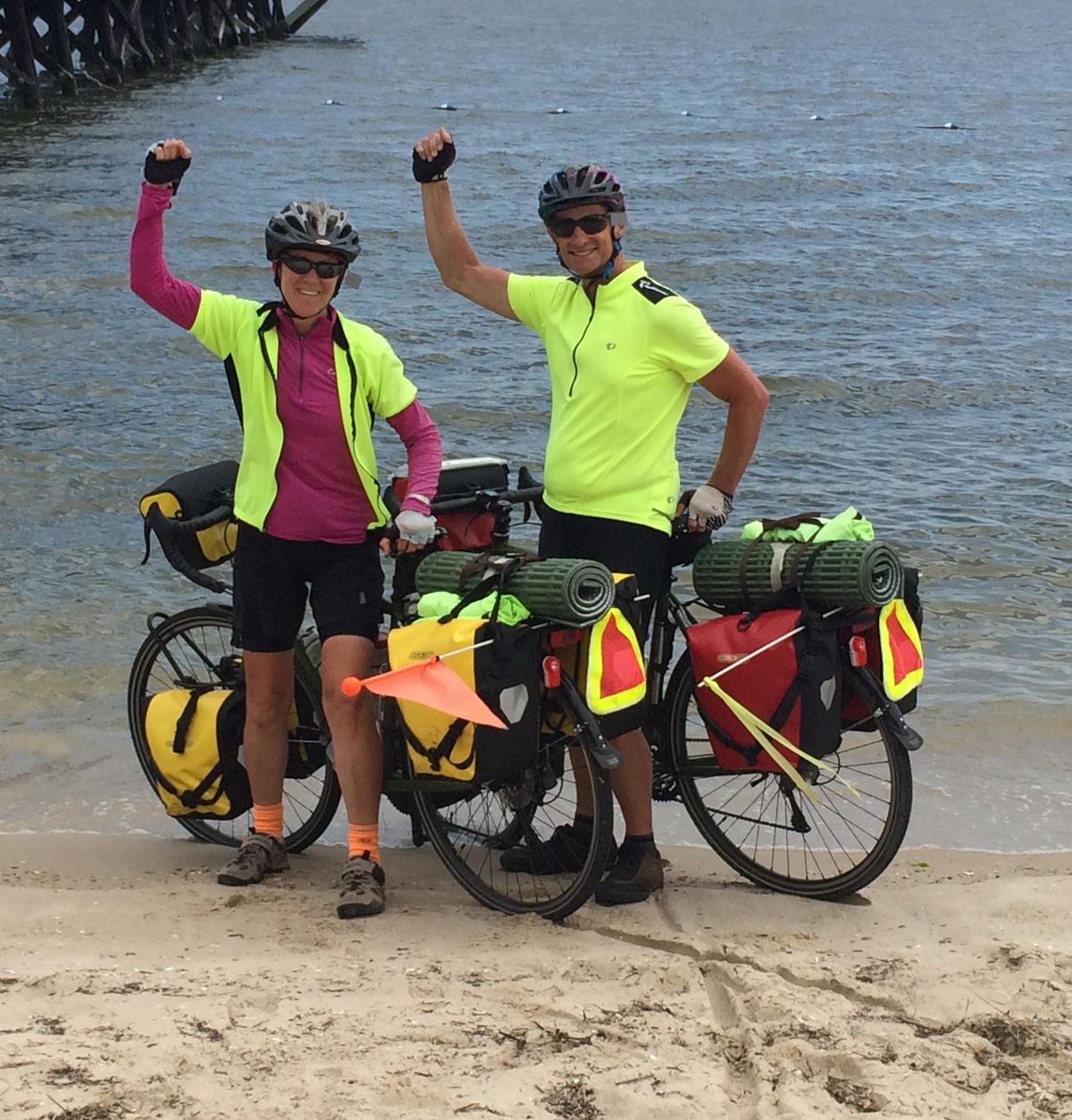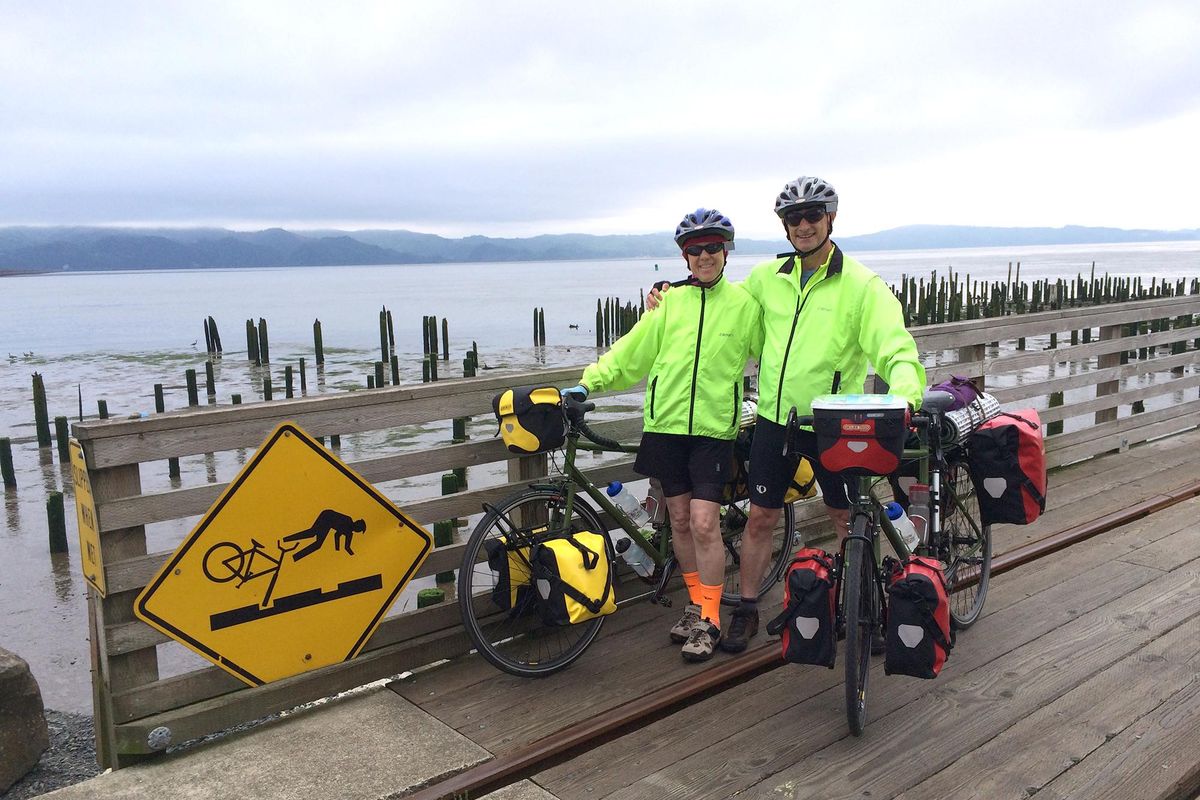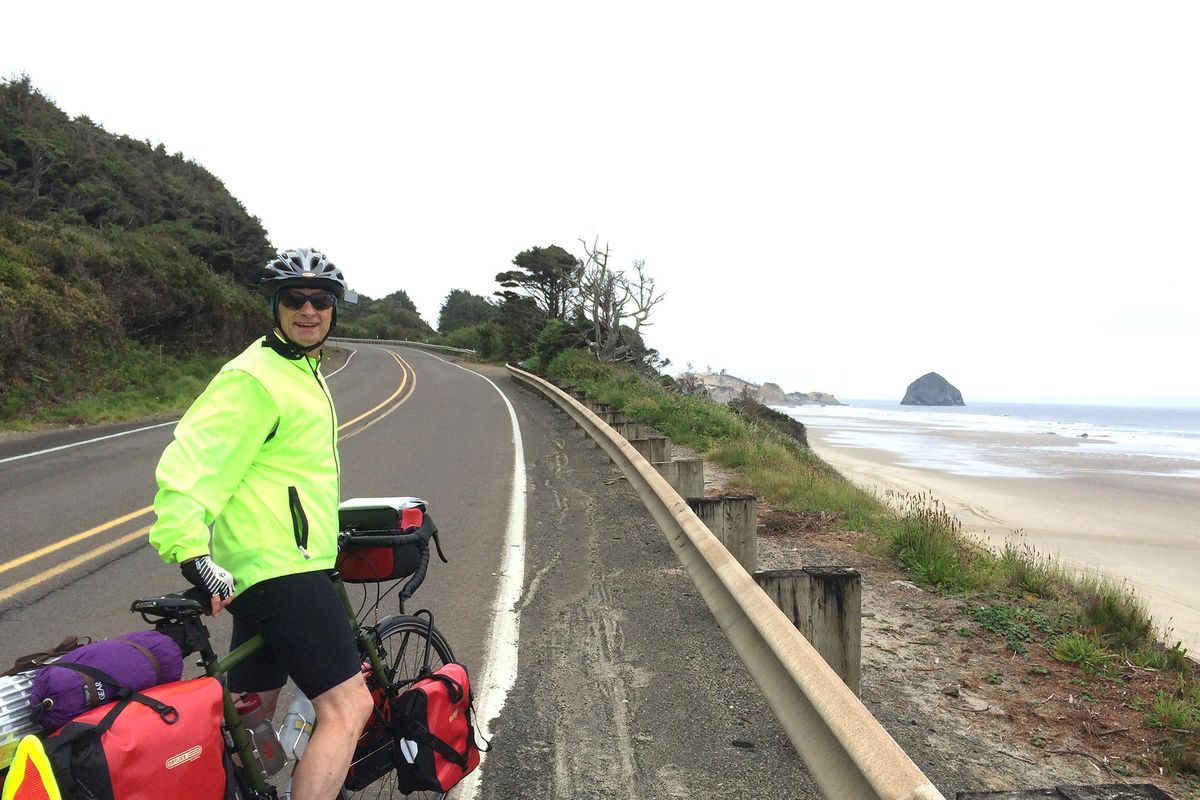Two for the Road: TransAm bike tour bridges generation gap
Mary and Larry Wright began their 2015 bicycle tour across the United States on the TransAmerica Bicycle Trail at Astoria, Oregon. (COURTESY)
The crash barely makes the first half-hour of highlights in a conversation about their bicycle tour across the USA.
Mary and Larry Wright have some 4,000 photos and hours of encounters they enjoy recalling from their 96-day adventure.
As for the crash: “Just a short break in the action,” Mary said.
The seed for riding the TransAmerica Bicycle Trail was planted more than 30 years ago, Larry said, “when a certain Spokane outdoor writer who’d ridden across the country wrote a story calling the bicycle the RV of the ’80s.
“A decade or so later, we came to learn my grandad had ridden a bike from Kansas to northern Idaho in 1897 to homestead. That kind of inspired me.”
“We wanted to do something to inspire our grandkids in the same way,” Mary said.
As the Wrights were pushing retirement last year, their conversations about committing to a big bike tour finally pushed them over the brink.
“Neither of us was 65, but we retired to do this,” Larry said. “We used it as an excuse to cut the cord. Our bodies are changing and if we were going to do it, we should do it now.”
Mary retired after 32 years with Travis Pattern and Foundry and Larry terminated his career as a software engineer on March 31. Six weeks later, the Spokane Valley couple hit the road.
Friends drove them to Astoria where they attached front and rear paniers on their bicycles and began riding the Oregon Coast.
“Our friends later said they had to chuckle when they saw me ride off wobbling on my loaded bike,” Mary said. “They weren’t so sure I was going to make it all the way to Virginia.”
“We’d never done a bike tour before,” Larry said. “We did long rides like the Tour of the Swan River Valley (Montana), the Golden Triangle (British Columbia) and I had been bicycle commuting for 30 years, but we’d never put all our gear on bikes.
“A guy at work said we needed to do overnight shakedown trip before starting in Oregon. But we were so busy with the process of getting retired, we didn’t have time.”
“We’ve been backpacking and canoe camping for 30 years,” Mary said. “so the camping part was not a mystery to us. We had to grow into the biking part.”
Packing an ultralight tent, they settled in some choice campsites at city and state parks along the way.
“Lewis Lake Campground in Yellowstone stands out as a favorite,” Larry said.
At the other end of the spectrum was a grassy spot a fire station made available to cyclists.
“In the middle of the night, they woke us up and said we had to move our tent because there’d been an accident and a helicopter was going to land there,” Larry said.
This being a retirement trip, they never hesitated to eat at restaurants or check into a motel when that was the most comfortable or convenient way to go.
“We spent more money than we would have in our 20s,” he said.
“When it got hot and humid, a room with AC sounded pretty good,” Mary said.
They rode for a few days with another cyclist who was using the Warmshowers.org hospitality network and making his tour on about $50 a day.
“Overall, we averaged about twice that per couple,” Mary said.
Picking the hottest year on record had its advantages.
“In 90 days of riding, it rained on us only about three times,” Larry said. “We never pulled out our Gore-Tex, although we did sit out one big storm under the eve of a church.”
They had time, so they stayed flexible.
“If it was pouring rain, we took a layover day,” Larry said. “When it got got hot, we’d start riding before sunrise and stop for the day around 1 p.m.”
The TransAmerica Bicycle Trail was inaugurated in 1976 as a route linking backroads 4,300 miles through Oregon, Idaho, Montana, Wyoming, Colorado, Illinois, Kansas, Missouri, Kentucky and Virginia.
The route was mapped by a Missoula-based group called Bikecentennial for the nation’s 1976 Bicentennial Celebration.
Bikecentennial evolved into the Adventure Cycling Association, which continues to produce ever-better maps of the TransAm Trail, two additional cross-country trails and numerous other routes, short and long, on the continent.
“The maps are fantastic for showing the route and all the bike shops, food stops, campgrounds and things like that along the way,” Larry said.
Because the designated trail attracts a steady stream of cyclists, locals in some areas provide services such as bike inns, where bike shops, fire stations and churches provide places for cyclists to get a shower and shelter for the night.
But even on a well-mapped route, things don’t always go as planned.
“We were going to have an easy ride the first day into Yellowstone,” Larry said. “But the first campsites we tried were closed because of bear problems. We had to do two or three more Continental Divide crossings to reach a campground open to cyclists near the southern exit of the park.”
Their longest day stretched to 90 miles after a hotel they’d booked gave away their room – to other cyclists.
A tip they offer to traveling couples: “Consider having two different mobile phone services,” Mary said. “With just AT&T we were frequently without service.”
The Wrights say they can’t pick a most beautiful state because they all had their moments of grandeur.
“To me, the highlights of the trip were the high points, the passes we crossed in the Cascades as well as the ones in the Appalachians, which aren’t as high but just as challenging as those in the Rockies,” Larry said. “Even after pedaling 3,000 miles, those Appalachian roads were steep.”
“We highly recommend having a bike with a very low gear,” Mary said. “I had some times when I still ended up pushing my bike. But looking back, there was never a moment when I felt the trip wasn’t a good choice.”
She was not deterred even by the day in Kentucky when her front wheel caught the edge of ragged pavement on a narrow road as traffic stacked up behind her, and she crashed.
“I suffered a severe shoulder injury, mostly soft tissue, no fractures,” she said. “I was going way too fast.”
They took a three-day break for convalescing and getting Mary’s confidence back.
“We discussed whether to head home at that point, but we were so close to finishing,” she said. “Only a couple more weeks.”
“The other notable highlight was the people, lots of interesting people,” Larry said. “When I started the trip, I though it was all about seeing backroads of America. The best part was the people.”
They had read an Adventure Cycling story that downplayed “mooching” while explaining that cyclists can “initiate kindness” in times of need simply by being themselves.
Sometimes locals seemed to sense when the couple was in a predicament for directions or a good place to stay and spontaneously would step up to offer help, Mary said.
“One father and son in Virginia wouldn’t let us ride away after a visit without taking a bag full of tomatoes,” Larry said.
They occasionally joined for a few days of riding with other cyclists on the TransAm Trail.
“We crossed paths with a lot of younger bikers, and they were all really cool,” Mary said. “Bikes bridged the generation gap.”
The Wrights said they were glad they’d been given the advice to buy sturdy touring bikes with low gearing rather than trying to make the tour on their lighter, more fragile road bikes.
Bifocal sun glasses would have been a good investment given the hassle of reading a map while on the road, Larry said.
Pressed to single out the most important piece of advice for a couple planning to bike across the USA, Mary didn’t hesitate: “Don’t rush it.”
“By the last few weeks of the trip we started a discussion of how we had to wean ourselves from eating so much, because when you’re biking every day you can pound down anything you want,” Larry said.
“Now I wouldn’t be able to eat half the huge stack of blueberry pancakes I polished off in Riggins, Idaho.
They ended their odyssey by dipping bike tires in the Atlantic ocean with Larry’s bike odometer reading 4,430 miles.
“We did a little more sightseeing, but by that time we were starting to miss the family, and anxious to get back to our seven grandkids,” Mary said.
“What strikes me now is that I have several thousand pictures, and most of them are from roads that anybody could have taken from a car.
“But between the photos and my hand-written journal and the effort it took to do the trip, there’s no way to come home with the same experience in a vehicle.”












